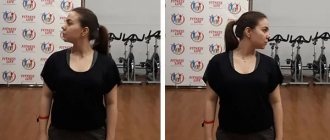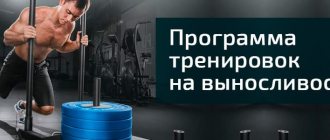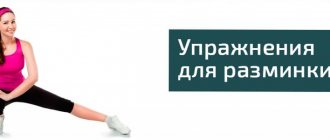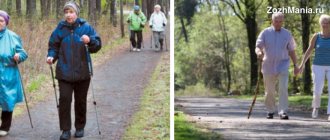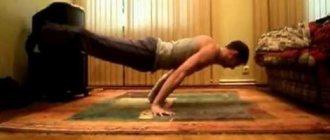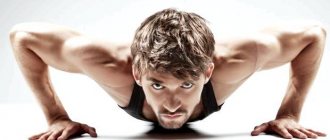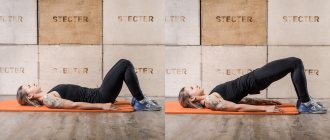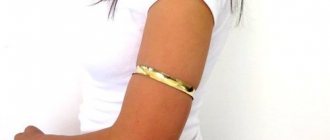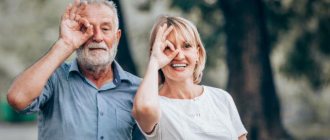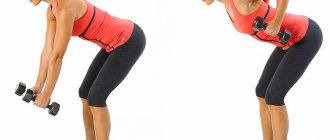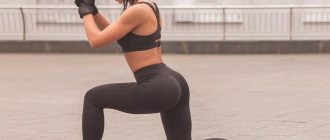Millions of people do light exercise every morning after waking up. Some people get a boost of energy, others warm up, and for others it’s a habit.
What is morning exercise, why is it needed and what are the rules for doing it?
History of charging
It is unknown who invented physical education and when, but references to it came to us from ancient times. In our country, the complex of morning exercises began to be popularized in the twenties of the twentieth century.
In 1929, for the first time, lessons developed by the USSR Institute of Physical Culture were heard from all radio receivers in the country.
For residents of the Union, physical education after waking up became a familiar ritual with which the day (shift, work) began.
Several generations received a boost of energy thanks to Nikolai Lavrentievich Gordeev, whose voice voiced the exercises themselves and their sequence.
Since then, in our country (with a break during wartime), the postulate “A healthy mind in a healthy body” has become familiar to all categories of citizens who strive to be vigorous, young and not get sick.
Why do you need to do exercises in the morning?
Morning exercises are of a healing nature. It must be done regardless of whether you visit the gym or not. This type of physical activity helps combat drowsiness and fatigue in the morning. Morning exercises are especially useful for those who feel overwhelmed and even unhappy every morning. If this is familiar to you and you want to get rid of chronic fatigue, then follow two rules: healthy sleep for at least 7 hours and morning exercises for 15–20 minutes.
In addition, morning physical education classes will help set an active pace for the working day. This will affect your mood, irritability will be replaced by positivity and patience. Even difficult work will not cause strong emotional stress as before. Thus, from morning exercises you get a huge amount of energy, which is so necessary during the day for a purposeful, busy person.
orpro rp
What is charging?
The set of exercises for morning exercises is optimal for each person, but basically it consists of:
- tilts;
- shallow squats;
- stretching;
- push ups;
- twisting;
- stretch marks;
- flexion-extension.
Physical education allows you to work out the joints of the knees, chest, pelvis, neck, as well as muscles.
Morning exercises standing (emphasis on the lower body)
Light morning exercises are performed immediately after waking up. If you have little strength, no desire, or are simply lazy, then you can start with stretching while lying down. Movements should not be sharpened, smoothness is important, no haste. The total time for gymnastics should not exceed 10-15 minutes, since the goal is to tone the body and awaken, and not to pump muscles. The second complex consists of ten exercises for the lower half of the body: lower back, pelvis, buttocks and thighs.
You can perform all 20 exercises presented in one day (upper body and lower body), or alternate two programs of 10 exercises every other day. If desired, you can perform the exercises in two circles.
Circular rotations of the pelvis
What are the benefits: Warming up the lumbar region and hip joints, returning tone to the abdominal muscles, relieving pain in the back. The usefulness of this exercise is also noted for digestion, kidneys, and genitals.
How to do it: Place your feet two shoulder-widths apart, place your palms on your waist, and straighten your back. Rotate your pelvis in a circular motion to the right. Do not tilt your head from the axis, do not help with your body and legs, maintain a wide amplitude for effect. Then repeat the circles to the left.
How much to perform: 5-6 rotations in one direction, then 5-6 rotations in the other direction.
"Good morning" with arms straightened
What are the benefits: Strengthening and enlarging the gluteal muscles, developing flexibility with elasticity for the hamstrings. The back works actively when exercising in the morning: from the spinal extensors with the upper sections to the lumbar region. This exercise is especially useful for people who lead a sedentary lifestyle.
How to do it: Spread your feet one and a half shoulder widths apart, straighten up, put your hands behind your head, clasping your palms. At the same time, begin to move your pelvis back to stretch your hips and slightly bend your knees, while leaning forward until parallel to the floor. At this point, straighten your arms, bring them back and gently rise.
How much to do: 6-8 bends.
Squats with arms up
What is the benefit: Increased functionality and mobility of the lower body, which helps in everyday life. Fat burning is stimulated, the heart and blood vessels are strengthened as it is performed, coordination is improved, and joint health is maintained. In the exercise, the legs, buttocks, and back work.
How to do it: Place your feet at a comfortable distance for a squat and turn your toes out slightly. Straighten your back and raise your arms above your head. Do a squat using the classic technique - pelvis down and back, knees straight along your feet, without tilting inward. Place your hands between your thighs. Return to the starting position.
How much to do: 8-10 squats.
Bend your leg forward and bend it back
What are the benefits: Evenly working out the back, buttocks and thighs. Improves flexibility and mobility of the spine and hip joints. The abdominal muscles are strengthened and strengthened. The leg biceps and hamstring ligaments and tendons are stretched. Blood and lymph circulation throughout the body is restored.
How to do it: From a standing position, place your right foot slightly forward on your heel. Straighten your arms above your head. Now bend over, slightly bend the knee of your supporting leg, stretch your palms towards your feet. At the same time, try to bring your stomach to your thigh. Rise up, stretch your arms up, place your right leg slightly back on your toes. Bend well in your back. Repeat one more time.
How much to do: 5-6 bends on one side, 5-6 bends on the other side.
Swing your feet forward
What is the benefit: Toning the muscles of the lower half of the body. The muscles of the abs, back and upper shoulder girdle are also involved. The hamstrings and biceps are stretched, and the musculoskeletal system is developed. From the swings comes an exercise for standing exercises, giving freedom of movement.
How to do it: Return to your normal stance – feet shoulder-width apart, straight back, arms along your body. Swing your right foot forward and slightly diagonally, at the same time extend your left hand forward, touching your palm with your toe. Lower, repeat with the other leg. Don't lean forward too much.
How much to perform: 5-6 swings on each side (10-12 in total).
Mill without body extension
What are the benefits: Creating a sculpted and toned waist, eliminating fat deposits from the sides, strengthening the muscles of the abdomen and back. The legs are also included when bending over, and the shoulder girdle when moving the arms. The abdominal wall is strengthened along its entire length, which means that the morning exercise exercise tones the organs.
How to do it: Spread your feet wider, stand tall, and straighten your arms to your sides. Lean forward, keep your back straight. Use your left hand to reach your right toe, twisting the body. Without straightening, turn to the other side and switch hands to touch your left toe with your right palm.
How much to perform: 5-6 touches on each side (10-12 in total).
Bend to the side in a sumo squat
What are the benefits: Increased core and abdominal strength, pumping up the buttocks and hips. This exercise strengthens the pelvic floor muscles, deep fibers along the vertebrae from the neck to the sacrum, and tightens the inner surface of the legs. This movement is included in exercises in the morning due to increased blood flow and metabolism. Increasing calorie consumption leads to active fat burning and stimulation of weight loss.
How to do it: Place your feet wide apart and point your toes out to the sides. Lower yourself into a sumo squat. Hips parallel to the floor, knees in the direction of the feet, back straight. Raise your hands up. Bend to the right and reach your heel with your hand. Come back, then repeat to the left side.
How much to perform: 5-6 turns on each side (10-12 in total).
Side lunges with reversals
What are the benefits: Working out the buttocks and thighs with an emphasis on the adductors, as well as increasing leg strength. The knee joints are developed, and the sense of balance and coordination increases in lunges. The roundness of the buttocks improves, which visually normalizes the figure and gives relief to the quadriceps and biceps. Additionally, the oblique muscles of the abdomen and arms work due to turns.
How to do it: Leave your feet wide apart, clasp your hands in front of you, straighten your back. Shift your body weight to the left, lower your pelvis down until your thigh is parallel to the floor. In this case, the body turns to the side so that the right hand touches the left leg. The left hand reaches up and to the side. Then now move your torso to the right, straightening your knees, but without straightening your body too much, and repeat the same on the other side.
How much to perform: 5-6 turns on each side (10-12 in total).
Bends down with feet touching
What is the benefit: Stretching the hamstrings, glutes and adductors. This type of bending also engages the back muscles. The elasticity of the muscle fibers on the back of the legs increases, relaxation occurs, and the flexibility and mobility of the hip joints improves. Blood flow increases.
How to do it: Place your feet two shoulder-widths apart and extend your arms above your head. Tilt your body forward and down and touch your right toe with your palms, then the floor between your feet, then your left toe. Keep your back down during this period, do not rise. Go back to the beginning, repeat.
How much to do: 6-8 bends.
Spinal traction with calf raises
What are the benefits: Normalization of breathing, relaxation of muscles, replenishment of energy and lifting mood. An excellent ending to light morning exercises, during which it is possible to disperse blood through the muscles after a static sleep position. Efficiency is stimulated and the overall tone of the body increases.
How to do it: Place your feet close to each other, lower your arms down, and straighten your shoulders and chest to complete the transition to the stance. In one movement, raise both arms up through your sides, stand on your toes, and stretch. Then lower yourself completely to the starting position. Watch your breathing.
How much to do: 6-8 arm raises.
See also selections for a healthy back:
- Exercises for straight posture
- Standing back exercises
- Exercises for lower back pain
- Back strengthening exercises
- 10 minutes to relax your back
Charging or combining with other procedures?
Morning exercises are useful both on their own and in combination with other procedures:
- rubbing;
- hardening;
- swimming;
- run.
Very often people combine several types of activities, complicate existing exercises or add new ones.
The main condition for effective gymnastics is to do everything in moderation and monitor your well-being.
Why do you need physical education at the beginning of the day?
Probably everyone knows the feeling when, getting out of bed, you can’t wake up, your muscles are numb, something is “short-circuited”, you’re too lazy to exercise. Gymnastics successfully combats this condition.
Exercises for morning exercises are initially selected in such a way as to improve blood circulation.
The lesson should be simple and short (no more than fifteen minutes). There is no need to overwork your body. We need to help him wake up and gradually prepare him for the daily load.
Unlike fitness, light physical exercise does not involve fatigue.
There is no need to prepare in any special way, because the whole complex is done to the best of one’s ability and desire. This not only improves blood flow, but also improves mood.
Some features
You need to know that each age has its own duration and a certain set of exercises. For example, charging time for children should not exceed ten minutes, as kids get tired quickly.
Very young children should be taught to exercise gradually and shown exercises during the game.
You need to stop classes when the child is tired so that he does not become overtired and lose interest in physical education.
When working with your child every day, it is necessary to complicate the exercises. You can do gymnastics outdoors or indoors, provided that it is well ventilated.
- Morning exercises for an adult should be 15-20 minutes, but no more than 30 minutes.
- You should not overload the body in the morning; it is better to perform another complex in the evening.
- For older people, charging time should be shorter, from 10 to 20 minutes.
- If you feel unwell, exercise should be stopped.
Recently, Finnish walking with sticks has become very popular among older people. This sport is an excellent replacement for morning exercise.
Who can do physical education?
Morning exercises are beneficial for almost everyone! For adults and children, sick and healthy, men and women.
The only strict rule is that in case of disturbances in the functioning of the body, classes should be conducted by a specialist in physical therapy, a rehabilitation specialist.
Gymnastics for kids
From birth, mothers do light exercise for their babies every day. Over time, the exercises become somewhat more difficult.
Morning exercises for preschool children are mandatory for their harmonious physical development. To interest the children, classes are conducted in a playful way with cheerful music.
Regular exercise accustoms children to a routine, trains their willpower, and develops the ability to be responsible.
In addition, a child who exercises every morning after sleep quickly becomes cheerful, has a good appetite and is in high spirits.
In preschool institutions, children do gymnastics every day before breakfast, which is appropriate for their age and physical capabilities.
Exercises for women
Representatives of the fair half of humanity are always worried about their appearance, health and figure.
Morning exercises are a great way for women to keep themselves in good shape.
Low-intensity physical exercise performed after waking up triggers processes that improve metabolism, allowing you to burn excess fat.
In addition, if you include the “eastern” complex in the exercise, it has a beneficial effect on the functioning of the reproductive system.
Unlike intensive training, gymnastics can be performed throughout the month, if your health allows.
Why do exercises?
To be alert and focused in the morning
Physical exercise improves blood circulation, the brain receives more oxygen and begins to work at full capacity.
As a result, attention, concentration and memory increase. Just 10 minutes of exercise improves Executive-related oculomotor control is improved following a 10-min single-bout of aerobic exercise: Evidence from the antisaccade task cognitive ability by 14%.
To maintain a good figure
Exercise on an empty stomach accelerates Exercise Increases 24-H Fat Oxidation Only When It Is Performed Before Breakfast fat oxidation for the whole day after a morning workout. They also increaseTraining in the fasted state improves glucose tolerance during fat-rich diet sensitivity to insulin, a hormone that plays a big role in maintaining normal weight.
To cheer you up
Exercise improves well-beingDifferential effects of acute and regular physical exercise on cognition and affect and helps fight stress.
Exercises for pregnant women
Women who are in an interesting position always pay a lot of attention to their health and well-being, since the life and health of the baby depends on it.
A healthy lifestyle is mandatory for pregnant women. It includes light physical activity: walking, special gymnastics, breathing training.
Unfortunately, not all types of activities are always acceptable during pregnancy. But a light warm-up of muscles and joints after sleep, approved by a gynecologist, should be included in the daily routine at any time.
How to stretch
All exercises are performed softly and smoothly, without jerking or strong pressure. Now is not the time to set records - a pleasant tension in the muscles is enough.
Stretch with arms raised
Stand up straight, place your feet together, raise your arms above your head and clasp your palms together. As you inhale, tighten your buttocks, stretch up, and then bend back at the thoracic region. Hold the pose for a couple of seconds to give your muscles a good stretch.
Forward lean
As you exhale, bend forward without bending your knees. Make three springing movements, each time slightly deepening the tilt. Do not try to reach the floor, the main thing is to gently stretch the muscles, and not set a record for the depth of the bend.
Deep lunge forward
Take a few steps with your hands on the floor until you lie down. Place your right leg next to the inside of your right arm, straighten your left knee, place your foot on the ball. Make 3 springing movements, deepening the pose.
Side turns
Without coming out of the lunge, turn your body to the right and extend your right arm to the ceiling. Your chest should be facing the wall to your right. Hold the pose for 3-5 seconds and return to the starting position.
Downward Facing Dog Pose
Stand in a lying position, push your pelvis up, lift your heels off the floor, bend your knees and stretch your arms and back in one line. If stretching allows, you can straighten your knees and place your heels on the floor. But at the same time, the back must remain straight - this is the main condition for correct execution. Spend 3-5 seconds in the pose.
From this position, return to the prone position, repeat the deep lunge with your left leg and turn your body to the left. Then return to Downward-Facing Dog for another 3-5 seconds.
Cat-cow and side turn
Get on all fours, arch your back, lower your head. Then bend in the opposite direction, keep your neck in a neutral position, do not throw your head back. Perform 3 cycles of back flexion and extension.
Turn your body to the right, leave your left leg on your knee, and extend your right leg. Point your right hand towards the wall behind your head. The arm, body and leg should extend into one line. Spend 3-5 seconds in the pose.
Return to all fours, do three cat-cow exercises and repeat the turn to the left.
Child's pose
Sit on your heels, bend over, lie on your stomach between your thighs and stretch your arms forward. Relax for a few seconds.
Deep squat
Raise your body, spread your shins wider, place your feet on the balls of your feet, push your pelvis back and go into a deep squat. Keep your back straight, fold your arms in front of you, and turn your knees to the sides.
The squat should be as deep as you can keep your back straight. Make 3 springing movements in this position and rise.
Intensive loads
There are no fundamental differences between morning exercises for men and women.
Representatives of the stronger sex prefer to supplement their exercises with push-ups, parallel bars exercises, and other strength complexes.
Physiological characteristics allow them not to experience significant discomfort during increased stress after sleep.
Set of final exercises
The final exercises are an important stage of charging.
- Place one hand on the belt, and raise the other up and tilt in the direction where the hand lies on the belt. Do the bends one by one.
- Extend your arms in front of you. Raise your legs one at a time so that the toe of your right foot touches the toes of your left hand and vice versa. Do ten swings with each leg.
You can complete your morning exercises by bending forward and exhaling deeply:
- Raise your hands up and take a deep breath;
- Leaning down, exhale deeply, while relaxing your arms so that they dangle freely. Repeat the exercise five times.
Rules and recommendations for implementation
The gymnast that we are all used to doing in the morning does not require any special rules. It is important to observe only the following:
- The room should be well ventilated.
- The space intended for performing the complex allows you not to “catch” anything during exercises.
- It is recommended to choose cheerful and rhythmic music for morning exercises.
- Gradually increase the load intensity and then decrease it.>
- After classes, it is best to take a contrasting, invigorating shower.>
- A hearty breakfast will complement the effect of wellness treatments.>
Lymphatic drainage exercise
Mostly girls over 25 years old experience swelling and varicose veins. Let's figure out how to properly do exercises in the morning to avoid this problem, and what set of exercises can help.
Lymphatic drainage exercises tone lymphatic and blood vessels, accelerate lymph flow, strengthen skin turgor and reduce the appearance of cellulite. It accelerates the removal of excess fluid from the body, thereby achieving a reduction in body volume.
- Warm-up : perform 10 tilts to the right and left, 10 arm swings and jumps.
- Lunges : stand straight, hands on your waist, take a wide step forward with your foot, bend the other leg so that your knee touches the floor. Repeat with the other leg.
- Hip abduction : Get on all fours, move your bent leg to the side, repeat with the other leg. This exercise strengthens the hip joint.
- Squatting steps : Sit on your haunches and walk around the room in this position.
- Crunches : Lying on the floor, raise your legs bent at the knees and stay in that position. Place your hands behind your head and perform body lifts, trying to touch your knees with your elbows.
- Dynamic Plank : Get into a plank position, resting on your elbows. Then lift your left hand off the floor and touch your right shoulder. Return to the starting position and perform the movement with your second hand.
Daily morning exercises for women will be an excellent investment in their own beauty, youth and health. The complex has no age restrictions, but girls over 25-30 years old will appreciate it most.
Variety
Morning exercises are divided into types if they are performed in an organized manner under the guidance of a trainer.
The composition of individual classes depends solely on the preferences of the person performing the exercises.
For groups, a warm-up complex is developed by trainers taking into account the physiological characteristics of the participants.
In kindergartens and holiday camps, exercises happen:
- standard (use of general strengthening and developmental techniques)
- plot (theatrical and physical recreation of any group action)
- gaming (team games)
- dance-rhythmic
For adults, for different age groups, the trainer conducts classes taking into account medical recommendations and health indicators of the people involved:
- standard;
- lightweight;
- for people suffering from diseases of the musculoskeletal system;
- intended for patients with disorders of the central nervous system;
- other types designed for health characteristics.
Therapeutic bed exercises
1. Lying on your back, do an intensive massage: with your thumbs behind your ears, with your palms pressed, move from top to bottom 30 times so that your index fingers move along the ears. Full concentration, eyes closed.
Physiological effects
(everywhere
FV
): protects the face from wrinkles, improves vision, strengthens teeth, increases blood circulation in the temporal region, and has a strengthening effect on the functioning of all internal organs and systems.
2. Place the palm of the right hand on the forehead, the left hand on the right and move along the forehead: left and right 20 times so that the little fingers move above the eyebrow. FV
: increases blood circulation and improves blood circulation in the brain, eliminates stagnation of venous blood and reduces headaches, activates mental ability, calms the nervous system, improves vision and protects the eyes from diseases. 3. Using the back of your large bent fingers, massage your eyeballs, up and down, using medium-intensity pressure – 1-5 times.
FV
: protects the eyes from diseases and aging, improves vision, calms the nervous system, improves blood circulation to the muscles and skin of the face.
4. With bent palms of your hands, massage the thyroid gland from top to bottom, hugging the latter 30 times.
FV
: improves the regulation of metabolic processes and the functioning of internal organs, strengthens the nervous system. 5. Massage your stomach: place your right palm with its edge on your bare stomach. Place your left palm on your right palm for weights and make clockwise circular movements 20-30 times, but so that you move up and down. This is achieved by turning the palm.
FV
: blood circulation improves, food absorption process improves, peristalsis increases, abdominal muscles strengthen, internal organs are massaged. 6. Lying on your back, strongly pull your stomach towards your spine, pressing your hands on your stomach, and then inflate your stomach - 20 times (this must be done several times during the day).
FV
: has a beneficial effect on the functioning of the liver, kidneys and gastrointestinal tract. Eliminates stagnation of bile and blood. Helps get rid of excess fat in the abdominal area, stimulates the circulatory system, cardiovascular and respiratory systems, relieves nervous tension. 7. Lying on your back, alternately pull your leg towards your chest so that all internal organs are massaged. 15 times each leg.
FV
: improves the functioning of all internal organs, strengthens the abdominal wall, stimulates the digestive system, bile formation and excretion, improves overall blood flow, promotes weight loss. 8. Sitting on the bed, lower your feet to the floor, place them on your right hand, massage the indentation of the foot with the palm of your right hand - 20 times, then the indentation of the other leg - 20 times.
FV
: treats rheumatism, gout, regulates heart function, reflex effect on the work of all internal organs, tonic effect on all body systems. 9. While continuing to sit, make a “lock” of your fingers, place them on the back of your head, massage it in both directions or up and down 10 times, tilting your head back, while your hands offer resistance.
FV
: improves blood circulation and movement of cerebrospinal fluid, eliminates venous congestion, stimulates hair growth, improves trophism of the cervical spine. 10. While continuing to sit, place your palms on your ears, press tightly and alternately hit the back of the head with the fingertips of both hands, thus creating vibration - 20-25 times.
FV
: stimulates the cerebral cortex, protects against deafness, relieves tinnitus, improves blood supply to the brain, treats headaches.
After morning exercises, it is recommended to sip a glass of raw water with a spoonful of honey infused in the evening.
How to choose exercises?
If there are no diseases that require special conditions for conducting classes, then a video of morning exercises can be found on the Internet.
When performing the exercises found, you need to listen to how you feel. It is important to remember that the essence of exercise is a warm-up after sleep, not a workout.
If you have health problems, you should select a physical training complex only after consulting a doctor or a specialist in physical therapy.
Standard gymnastics, familiar to us since childhood, is constantly supplemented with new exercises and improved.
In modern society, which advocates a healthy lifestyle, people devote a lot of time to physical education and sports. Sometimes for at least an hour after waking up.
Today, exercise has been replaced by Pilates, yoga, jogging, training with iron, exercise equipment and others. Each of these types of physical education can be considered gymnastics.
But it is worth remembering that the best morning exercise is a set of exercises that gives vigor and good mood, and does not leave behind fatigue and muscle pain.
Warm-up exercises
This photo of morning exercises shows warm-up movements.
- Circular rotations of the head and neck. You should tilt your head to the right and then to the left. Then bend your head forward so that your chin touches your body and back. Rotate your head clockwise and counterclockwise. Turn your head to the right and left.
- Clasp your hands, raise them to chest level and make rotational movements with your hands, then with your elbows. Bend your elbows or extend them, making circular movements with your shoulder joints.
- Warm-up for the core consists of the following set of exercises: put your hands on your belt and make circular movements with your hips clockwise and counterclockwise. Next, you should bend to the left and right legs alternately, reaching your toes with your fingertips.
- Leg workout. Raise your leg, bending it at the knee and rotate the ankle joint. In this case, you can rest your hand on the wall to maintain balance. Walking in place.
